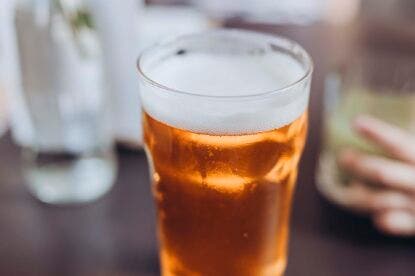The beautiful bite of that first swig of cold beer is unparalleled refreshment. But what impact does temperature have on beer, beyond the icy grip of revitalization and relaxation? Contrary to popular belief, cold temperatures aren’t the be-all and end-all of beer service.
“The short answer is, serve beer too cold and you won’t be able to taste everything,” says Shana Solarte, Advanced Cicerone, content manager for Cicerone and educator for Dovetail Brewery. “Serve beer too warm and you might not enjoy drinking it!”
When beer is too cold—around 32–35°F—Solarte says, it becomes hard for the drinker to taste or smell the full range of flavors in the glass. At lower temperatures, carbon dioxide becomes much more soluble—you’ll know this if you’ve ever accidentally frozen and then thawed a beer and opened it to find very little fizz.
“Cold liquid holds much more CO2 in solution than a warm liquid,” says Natalya Watson, beer sommelier and Advanced Cicerone. “So, if we serve a beer too cold, the bubbles, and, all importantly, those aroma molecules, remain trapped in the beer, dulling our overall flavor experience. Conversely, if we serve a beer too warm, the bubbles and aromas escape before we’re fully able to enjoy them.”
Not only does temperature impact the ability of all those flavor compounds to reach our olfactory centers, but it also impacts our physical ability to taste what we’re drinking.
When to Serve Beers on the Warmer Side
“We’re most sensitive to taste when the temperature in our mouth is between 71–98°F,” says Solarte. “So, an ice-cold beer might actually drop the temperature on your tongue so low that you can’t physically experience the full extent of what you’re tasting.”
Everyone knows the discomfort of a warm beer, but there are indeed cases to be made for beer being served a little warmer than straight out of the refrigerator. Cask beer, for example, mostly found in the United Kingdom, is served at “cellar temperature,” or a little cooler than room temperature, roughly 50–55°F. Beers with broader flavor spectrums, such as imperial, barrel-aged or flavored stouts, are also better served at slightly higher temperatures to allow the drinker to experience those flavors.
Some beers can be served from 50–55°F, or even up to 60°F.
“A high-alcohol stout or barleywine will really benefit from a slightly higher serving temperature, to allow the drinker to experience the full spectrum of flavors derived from the various malts and hops used when brewing, as well as the wide range of flavors created during fermentation,” says Solarte.
Alcohol levels can also provide clues about optimal serving temperatures. “Lower equals colder, higher equals warmer,” says Solarte.
Paler beers tend to perform better at cooler temperatures, too. “Generally, the more complex the flavor, the warmer you’ll want to serve it,” says Solarte.
A pale lager, for example, is, therefore, better suited to lower serving temperatures than a big, boozy stout.
When to Serve Beers on the Cooler Side
Generally speaking, ales are served a few degrees warmer than lagers. “This is because ale yeast produces more fruity and spicy aromatics than lager yeast, hence why lagers can be served slightly cooler as they’ve got a ‘cleaner’ flavor profile overall,” says Watson.
Solarte adds that lower temperatures also help diminish hop bitterness and ensure the beer’s thirst-quenching capabilities. Somewhere between 38–45°F would suit pale lagers well, though dark lagers like bock or schwarzbier can be served a few degrees warmer, from 41–48°F.
Pale ales and IPAs can be in the range of 45–50°F. You’re still looking for that same refreshment, though the broader range of flavors requires a touch more warmth in the glass. Lower-strength stouts, and the broad church of sour beer—from quick kettle sours to Berliner weisse and mixed fermentation beer like lambic or gueuze—also works well within this temperature range.
Although beer service and optimal serving temperatures are relatively exact sciences, in the end, it comes down to personal preference.
“Ordering a beer and drinking it slowly enough to allow it to warm up a few degrees between the start and end of the glass can be a really interesting tasting exercise,” says Solarte. “Take note of the flavors you perceive, or a lack thereof, at the first sip and see if some more complexity has developed by the last few sips. Or, try a beer at different temperatures by removing the bottle from the refrigerator 10, 20, or even 30 minutes before you plan to open it.”
Last Updated: July 10, 2023
















